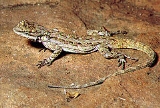
Urosaurus
Encyclopedia
The North America
n genus Urosaurus (the tree and brush lizards) belongs to the New World
Iguanian family Phrynosomatidae
. They can be distinguished from members of the genus Sceloporus by the presence of a gular (under neck) fold and granular lateral scales. They can be distinguished from members of the genus Uta
by the presence of enlarged (sometimes only slightly) dorsal
scales
. It has been used as a model system in lizard life-history studies and populations produce two or more clutches
of eggs
per year (Michel 1976, Ballinger 1984). Field studies have also shown a cost of reproduction in a natural New Mexico
population of the species Urosaurus ornatus
(Landwer, 1994).
North America
North America is a continent wholly within the Northern Hemisphere and almost wholly within the Western Hemisphere. It is also considered a northern subcontinent of the Americas...
n genus Urosaurus (the tree and brush lizards) belongs to the New World
New World
The New World is one of the names used for the Western Hemisphere, specifically America and sometimes Oceania . The term originated in the late 15th century, when America had been recently discovered by European explorers, expanding the geographical horizon of the people of the European middle...
Iguanian family Phrynosomatidae
Phrynosomatidae
Phrynosomatidae is a diverse family of lizards, found from Panama to the extreme south of Canada. Many members of the group are adapted to life in hot, sandy deserts, although the spiny lizards prefer rocky deserts or even relatively moist forest edges, and the short-horned lizard lives in prairie...
. They can be distinguished from members of the genus Sceloporus by the presence of a gular (under neck) fold and granular lateral scales. They can be distinguished from members of the genus Uta
Side-blotched lizard
Side-blotched lizards are lizards of the genus Uta. They are some of the most abundant and commonly observed lizards in the deserts of western North America. They commonly grow to six inches including the tail, with the males normally being the larger sex. Males often have bright throat colors....
by the presence of enlarged (sometimes only slightly) dorsal
Dorsum (anatomy)
In anatomy, the dorsum is the upper side of animals that typically run, fly, or swim in a horizontal position, and the back side of animals that walk upright. In vertebrates the dorsum contains the backbone. The term dorsal refers to anatomical structures that are either situated toward or grow...
scales
Scale (zoology)
In most biological nomenclature, a scale is a small rigid plate that grows out of an animal's skin to provide protection. In lepidopteran species, scales are plates on the surface of the insect wing, and provide coloration...
. It has been used as a model system in lizard life-history studies and populations produce two or more clutches
Clutch (eggs)
A clutch of eggs refers to all the eggs produced by birds or reptiles, often at a single time, particularly those laid in a nest.In birds, destruction of a clutch by predators, , results in double-clutching...
of eggs
Egg (biology)
An egg is an organic vessel in which an embryo first begins to develop. In most birds, reptiles, insects, molluscs, fish, and monotremes, an egg is the zygote, resulting from fertilization of the ovum, which is expelled from the body and permitted to develop outside the body until the developing...
per year (Michel 1976, Ballinger 1984). Field studies have also shown a cost of reproduction in a natural New Mexico
New Mexico
New Mexico is a state located in the southwest and western regions of the United States. New Mexico is also usually considered one of the Mountain States. With a population density of 16 per square mile, New Mexico is the sixth-most sparsely inhabited U.S...
population of the species Urosaurus ornatus
Urosaurus ornatus
The Tree lizard or Ornate Tree Lizard is a species of lizard that is native to the southwestern United States and northern Mexico. The species has been used to research the physiological changes in the body during the fight-or-flight response as related to stress and aggressive competition...
(Landwer, 1994).
Species
- Urosaurus auriculatus
- Urosaurus bicarinatus
- Urosaurus clarionensis
- Urosaurus gadovi
- Urosaurus graciosusUrosaurus graciosusThe long-tailed brush lizard, Urosaurus graciosus, occurs in the Mojave and northwestern Sonoran Deserts in the states of California, Arizona, Nevada, Sonora, and Baja California. This species received its common name due to its tail, which is more than twice the body length, and since it is almost...
- Urosaurus irregularis
- Urosaurus lahtelai
- Urosaurus nigricaudus
- Urosaurus ornatusUrosaurus ornatusThe Tree lizard or Ornate Tree Lizard is a species of lizard that is native to the southwestern United States and northern Mexico. The species has been used to research the physiological changes in the body during the fight-or-flight response as related to stress and aggressive competition...

